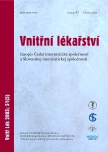Prevention of venous thrombosis and pulmonary embolism in the department of internal medicine
Authors:
J. Spáčil1 ,2; J. Spáčilová 1
Authors‘ workplace:
III. interní klinika 1. lékařské fakulty UK a VFN, Praha, přednosta prof. MUDr. Š. Svačina, DrSc., MBA
1; Subkatedra angiologie IPVZ, vedoucí MUDr. J. Spáčil, CSc.
2
Published in:
Vnitř Lék 2005; 51(5): 518-522
Category:
Original Contributions
Overview
From recent large controlled studies it is known that prevention of venous thrombosis and pulmonary embolism with heparin or low-molecular heparin in patients treated in the internal departments is indicated, effective and safe in all patients who have two and more risk factors for these disorders and who are not contraindicated. However, it is not known how the prevention is performed in practice, therefore we analysed clinical records of deceased with diagnosis of pulmonary embolism during two years and we studied clinical records of 411 patients hospitalised in the 3rd Medical Department of the 1st Faculty of Medicine and General Teaching Hospital during last months. We assessed the risk of venous thrombosis and pulmonary embolism and how their prevention with heparin or low-molecular heparin is practised. 69 patients died with the diagnosis of pulmonary embolism during two years. Autopsy was done in 40 patients and the diagnosis was confirmed in 25%. We found that pharmacological prevention was performed in 52%. The prevention was indicated in 200 patients from 411 hospitalised patients, i.e. in 48.7%. In these patients, where the pharmacological prevention was indicated, in fact it was not performed in 49% and it was done in 51%. In these patients the prevention was performed sufficiently in 60%, while suboptimal doses of heparin or low-molecular heparin were used in 40%. The situation was least favourable in patients with malignant tumours. The degree of pharmacological prevention of venous thrombosis and pulmonary embolism is not ideal in our clinic; however it is similar or even better than it is shown in world research literature where this topic seems to be still sporadic. The results imply that prevention of thromboembolic disease in patients in hospital's internal departments is not performed extensively and intensively enough.
Key words:
venous thrombosis – pulmonary embolism – prevention – heparin
Sources
1. Urbanová D, Staněk V. Tromboembolické příhody na kardiologickém pracovišti. Čas Lék Čes 1990; 129(24): 747–750.
2. Pineda LA, Hathwar VS, Grant BJB. Clinical suspicion of fatal pulmonary embolism. Chest 2001;120 : 791–795.
3. Geerts WH, Heit JA, Clagett GP et al. Prevention of venous thromboembolism. Sixth ACCP consensus conference on antithrombotic therapy. Chest 2001; 119(1): 132S–159S.
4. Widimský J, Malý J. Akutní plicní embolie a žilní trombóza. Praha: Triton 2002.
5. Lindblad B, Sternby NH, Bergqvist D. Incidence of venous thrombolism verified by necropsy over 30 years. Brit Med J 1991; 320 : 709–710.
6. Horlander KT, Mannino DM, Leeper KV. Pulmonary embolism mortality in the United States, 1979–1998: an analysis using multiple-cause mortality data. Arch Intern Med 2003; 163(14): 1711–1717.
7. Goldhaber SZ, Visani L, DeRosa M. Acute pulmonary embolism: clinical outcomes in the International cooperative pulmonary embolizm registry (ICOPER). Lancet 1999; 353 : 1386–1389.
8. Morgenthaler TI, Ryu JH. Clinical characteristic of fatal pulmonary embolism in a referral hospital. Mayo Clin Proc 1995; 70 : 417–424.
9. Goldhaber SZ, Tapson VF. A prospective registry of 5451 patients with ultrasound - confirmed deep vein thrombosis. Am J Cardiol 2004; 93 : 259–262.
10. Samama MM, Cohen AT, Darmon JY et al. A comparison of enoxaparin with placebo for the prevention of venous thromboembolizm in acutely ill medical patients. N Engl J N Med 1999; 341(11): 793–800.
11. Čepelák V. Prevence rizika hluboké žilní trombózy u interních nemocných. Inter Med Prax 2000; 5 : 24–28.
12. Fraisse J, Holzapfel L, Coulaud JM et al. Nadroparin in the prevention of deep vein thrombosis in acute decompensated COPD. Am J Respir Crit Care Med 2000; 161 : 1109–1114.
13. Kleber FX, Witt C, Vogel G et al. Randomized comparison of enoxaparin with unfractionated heparin for the prevention of venous thromboembolizm in medical patients with heart failure or severe respiratory disease. Am Heart J 2003; 145(4): 614–621.
14. Leizorovicz A, Cohen AT, Turpie AGG et al. Ranomized, placebo-controlled trial of dalteparin for the prevention of venous thromboembolism in acutely ill medical patients. Circulation 2004; 110 : 874–879.
15. Anderson FA, Spencer FA. Risk factors for venous thromboembolism. Circulation 2003; 107: I9–I16.
16. Vallano A, Arnau De Bols JM, Permanyer Miralda G et al. Use of venous thrombprophylaxis and adherence to guideline recommendations: cross-sectional study. Thromb J 2004; 2(1): 3–10.
17. Geerts W, Selby R. Prevention of venous thromboembolism in the ICU. Chest 2003; 124 : 357S–363S.
18. Ageno W, Squizzato A, Ambrosini F et al. Thrombosis prophylaxis in medical pateints: a retrospective review of clinical practice patterns. Haematologica 2000; 87(7): 746–750.
19. Stark JE, Kilzer WJ. Venous thromboembolic prophylaxis in hospitalized medical patients. Ann Paharmacother 2004; 38(1): 36–40.
20. McGarra LJ, Thompson D. Retrospective database analysis of the prevention of venous thromboembolism with low-moleculary-weight heparin in acutely ill medical inpatients in community practise. Clin Ther 2004; 3(3): 419–430.
21. Lee AYY, Levine MN. Venous thromboembolism and cancer: risks and outcomes. Circulation 2003; 107 : 1.17–1.21.
22. Kakkar AK, Levine M, Pinedo HM et al. Venous thrombosis in cancer patients: Insights from the Frontlinie survey. The Oncologist 2003; 8 : 381–388.
23. Elbl L. Poškození kardiovaskulárního aparátu při léčbě onkologických onemocnění. Vnitř Lék 2002; 48(7): 619–625.
24. Gorbunov EA, Wechsler J. Prognóza a prognostické faktory v onkologii a onkochirurgii. Vnitř Lék 2004; 50(1): 61–65.
Labels
Diabetology Endocrinology Internal medicineArticle was published in
Internal Medicine

2005 Issue 5
Most read in this issue
- Acute myocarditis, prevalence, diagnosis and treatment in local hospital
- Vasospastic angina pectoris – pathogenesis, diagnostics and treatment
- Our experience in the treatment of membranous nephropathy with cyclosporine
- Pneumology problems of patients with diabetes mellitus
